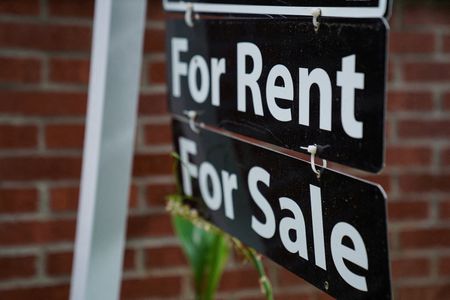By Ananta agarwal
(Reuters) – Small U.S. homebuilders are backing off from bringing more houses to the market, discouraged by a banking crisis-led credit squeeze and rising borrowing costs, industry experts said, exacerbating the shortage of new homes.
The housing market, which is one of the biggest casualties of the fastest rate-hike cycle in the U.S. since the 1980s, is also reeling with an acute supply squeeze due to a shortage of building materials and labor.
Adding to the woes, stricter lending criteria after the March collapse of Silicon Valley Bank is likely to slow the flow of credit to small businesses and households and hurt the affordability of buyers.
“I see a lot of small builders pulling back on some developments, sitting on the land, not moving the dirt until they see some relief in this market,” said Paul Schwinghammer, president of Indiana-based Hallmark Homes.
Schwinghammer builds about 80 homes a year and expects a 15% to 20% decline in new projects.
The slowdown in construction is beginning to show.
Housing starts, a key health indicator of the housing market, fell 18.9% in February, 19.4% in March and 25.6% in April, from a year ago, before increasing 5.7% in May, according to Federal Reserve Economic Data.
“I do expect tighter lending standards to weigh on housing construction as the year progresses and don’t look for the May pace of starts to be sustained,” said Nancy Vanden Houten, U.S. lead economist at Oxford Economics.
The latest Federal Reserve survey on lending practices showed 73.8% of 61 banks said they had tightened their credit standards for construction and land development loans.
Private homebuilders construct, if not sell, more than two-thirds of all single-family homes in the U.S., according to Robert Dietz, chief economist at National Association of Home Builders (NAHB).
“Tightened credit availability for these (private) builders would mean reduced inventory and choice for prospective homebuyers and potentially higher home prices,” said Dietz.
The NAHB expects total housing starts to decline to about 1.4 million or less in 2023, compared to 1.55 million in 2022 and 1.6 million in 2021.
The situation may not change soon given small builders are struggling to sell existing inventory as they cannot easily match the incentives from large public builders, said Kenneth Zener of Seaport Research Partners.
Meanwhile, large, public-listed homebuilders are beginning to fill some of the gap, with both Lennar Corp and Toll Brothers raising their full-year deliveries forecast.
Public builders’ share of housing starts for sale rose to 40% in the first quarter, up from 37% last year and 36% in the prior quarter, according to an analysis of census data by Seaport Research Partners.
(Reporting by Ananta Agarwal in Bengaluru; Editing by Sweta Singh and Arun Koyyur)





